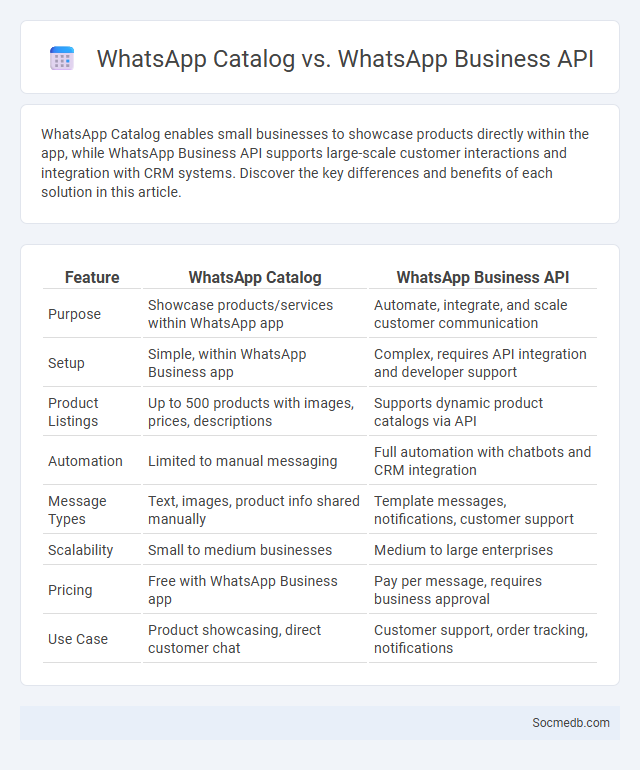
Photo illustration: WhatsApp Catalog vs WhatsApp Business API
WhatsApp Catalog enables small businesses to showcase products directly within the app, while WhatsApp Business API supports large-scale customer interactions and integration with CRM systems. Discover the key differences and benefits of each solution in this article.
Table of Comparison
| Feature | WhatsApp Catalog | WhatsApp Business API |
|---|---|---|
| Purpose | Showcase products/services within WhatsApp app | Automate, integrate, and scale customer communication |
| Setup | Simple, within WhatsApp Business app | Complex, requires API integration and developer support |
| Product Listings | Up to 500 products with images, prices, descriptions | Supports dynamic product catalogs via API |
| Automation | Limited to manual messaging | Full automation with chatbots and CRM integration |
| Message Types | Text, images, product info shared manually | Template messages, notifications, customer support |
| Scalability | Small to medium businesses | Medium to large enterprises |
| Pricing | Free with WhatsApp Business app | Pay per message, requires business approval |
| Use Case | Product showcasing, direct customer chat | Customer support, order tracking, notifications |
Introduction to WhatsApp Catalog and WhatsApp Business API
WhatsApp Catalog allows businesses to showcase products and services directly within the app, enhancing customer engagement through a seamless browsing experience. The WhatsApp Business API provides scalable messaging solutions for medium and large enterprises, enabling automated communication, order processing, and customer support at scale. Together, these tools empower businesses to streamline sales and improve customer interactions on a widely-used social media platform.
What is WhatsApp Catalog?
WhatsApp Catalog is a feature within the WhatsApp Business app that enables businesses to showcase their products or services in a mobile-friendly digital storefront. It allows companies to upload product images, descriptions, prices, and links directly to their WhatsApp profile, facilitating seamless customer browsing and direct communication. This tool enhances customer engagement by simplifying product discovery and purchase inquiries through a widely-used messaging platform.
Overview of WhatsApp Business API
WhatsApp Business API enables medium and large enterprises to communicate with customers at scale through automated and personalized messaging. Your business can integrate this API to send notifications, provide customer support, and streamline interactions using tools like chatbots and CRM systems. The platform supports secure, end-to-end encrypted messaging, ensuring privacy while enhancing business communication efficiency.
Catalog Feature in WhatsApp Business API
The WhatsApp Business API's Catalog feature enables you to showcase your products or services directly within chats, enhancing customer engagement and simplifying the buying process. This tool allows businesses to upload images, descriptions, prices, and product links, making it easier for customers to browse and inquire about items without leaving the app. Leveraging this feature optimizes sales conversions and streamlines communication by providing a seamless shopping experience.
Key Differences: WhatsApp Catalog vs WhatsApp Business API
WhatsApp Catalog allows you to showcase products directly within the app, making it easy for customers to browse and inquire without leaving the chat, ideal for small to medium businesses managing inventory simply. WhatsApp Business API targets larger enterprises, offering advanced automation, integration with CRM systems, and scalable customer communication, enabling personalized and efficient interactions at scale. Your choice depends on business size and communication needs, with Catalog focusing on product display and Business API enhancing customer engagement through automation and multi-channel support.
Use Cases: Who Should Use Each Option?
Social media platforms serve diverse audiences based on unique use cases: LinkedIn is ideal for professionals seeking networking and career growth, while Instagram caters to creatives and brands focused on visual storytelling and influencer marketing. Twitter suits real-time news updates and public conversations, whereas Facebook offers broad demographic engagement for community building and targeted advertising. TikTok attracts younger users prioritizing short-form entertainment and viral content creation.
Advantages of WhatsApp Catalog
WhatsApp Catalog offers your business an efficient platform to showcase products directly within the app, enhancing customer engagement by providing easy access to detailed product information and images. This tool streamlines the shopping experience by allowing potential buyers to browse your offerings without leaving the chat, accelerating decision-making and increasing sales potential. Leveraging WhatsApp Catalog enables you to build stronger relationships with customers through personalized communication paired with a seamless purchasing journey.
Benefits of WhatsApp Business API
WhatsApp Business API enhances customer engagement by enabling real-time communication and personalized messaging at scale, increasing response efficiency and satisfaction. It supports automation through chatbots and integration with CRM systems, streamlining sales and support workflows. Businesses benefit from global reach and secure messaging, improving brand trust and expanding market opportunities.
Limitations and Challenges
Social media platforms face significant limitations including data privacy concerns, algorithmic biases, and the spread of misinformation. User engagement can be hindered by content saturation, cyberbullying, and the challenge of moderating harmful or inappropriate content effectively. These challenges impact trust and user experience, necessitating ongoing advancements in platform security and content regulation.
Choosing the Right Solution for Your Business
Selecting the right social media platform depends on your target audience, industry, and marketing goals. Analyzing user demographics and engagement metrics helps identify platforms where your brand can maximize reach and conversion rates. Investing in tailored content strategies and social media management tools enhances brand visibility and drives business growth.
 socmedb.com
socmedb.com